story and photos by Kayte Deioma
The largest traditional Mexican market in Guadalajara goes by many 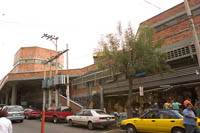 names. The official name is Mercado Libertad or Liberty Market. Most locals refer to it as Mercado San Juan de Dios ( St. John of God Market) after the nearby church and neighborhood of the same name. Still others call it Mercado “Taiwan de Dios” for the piles of imported electronics sold there. By any name, Latin America’s largest indoor market can keep you occupied and out of the rain for a good long while, even if you’re not a shopper. If you are a shopper, feel free to haggle, but keep in mind that wages in Mexico are really low, so don’t try to drive too hard a bargain.
names. The official name is Mercado Libertad or Liberty Market. Most locals refer to it as Mercado San Juan de Dios ( St. John of God Market) after the nearby church and neighborhood of the same name. Still others call it Mercado “Taiwan de Dios” for the piles of imported electronics sold there. By any name, Latin America’s largest indoor market can keep you occupied and out of the rain for a good long while, even if you’re not a shopper. If you are a shopper, feel free to haggle, but keep in mind that wages in Mexico are really low, so don’t try to drive too hard a bargain.
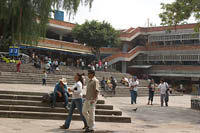 With over 1000 vendors, there’s not much for sale that can’t be found at the Mercado. The problem is that the market is so vast and the aisles are so narrow, that many people wander around for an hour and think they’ve seen it all, when they’ve barely scratched the surface. I can’t claim to be an expert. I spent about three hours and still only saw a fraction of what there was to see.
With over 1000 vendors, there’s not much for sale that can’t be found at the Mercado. The problem is that the market is so vast and the aisles are so narrow, that many people wander around for an hour and think they’ve seen it all, when they’ve barely scratched the surface. I can’t claim to be an expert. I spent about three hours and still only saw a fraction of what there was to see.
There are many entrances to the Mercado. If you’re walking around 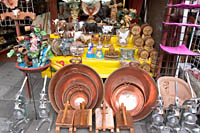 the plazas downtown, you’ll most likely be approaching from the north or west. From the north, you’ll probably want to skip most of the housewares in the outer booths along the long north side. If you don’t have a lot of time, walk along the outside of the market to where you see the more traditional copper vats and clay cooking pots.
the plazas downtown, you’ll most likely be approaching from the north or west. From the north, you’ll probably want to skip most of the housewares in the outer booths along the long north side. If you don’t have a lot of time, walk along the outside of the market to where you see the more traditional copper vats and clay cooking pots.
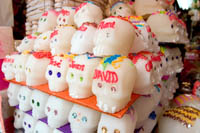 Keep an eye out on your way for some of the traditional Mexican sweets, like the sugar skulls for Day of the Dead. Then look for the basket vendor at the corner of an aisle that looks through to daylight on the other side. That should take you past hand made wooden toys, maracas and other arts and craft vendors on the way in to the patio.
Keep an eye out on your way for some of the traditional Mexican sweets, like the sugar skulls for Day of the Dead. Then look for the basket vendor at the corner of an aisle that looks through to daylight on the other side. That should take you past hand made wooden toys, maracas and other arts and craft vendors on the way in to the patio.
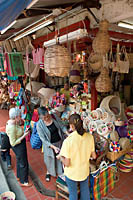 On the closest (north) side of the patio, you’ll find hand-woven baskets and bags, papier-mâché masks and dolls, clay and pottery miniatures and a wide variety of folk arts from the Guadalajara Metro area, the most important producer of hand crafts in the country.
On the closest (north) side of the patio, you’ll find hand-woven baskets and bags, papier-mâché masks and dolls, clay and pottery miniatures and a wide variety of folk arts from the Guadalajara Metro area, the most important producer of hand crafts in the country.
The south and western sides of the patio have produce vendors selling whole and cut up fruit, nuts, dried beans, yams and a variety of things I didn’t recognize and couldn’t translate (or find in a dictionary). The eastern side of the patio below the parking structure houses vendors of leather sandals, shoes and boots.
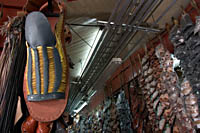 But if you’re looking for Mexican-made leather boots and sandals, you might want to start at the northern entrance that leads straight up the stairs to a row of cobblers and shoe vendors. You may spot one of Maximo Pelayo’s giant huarache sandals hanging at the top of the stairway above the rows of footwear made for normal-sized folks. His giant huaraches have found their way into Mexican restaurants and other establishments on both sides of the border. He makes them right there on the spot.
But if you’re looking for Mexican-made leather boots and sandals, you might want to start at the northern entrance that leads straight up the stairs to a row of cobblers and shoe vendors. You may spot one of Maximo Pelayo’s giant huarache sandals hanging at the top of the stairway above the rows of footwear made for normal-sized folks. His giant huaraches have found their way into Mexican restaurants and other establishments on both sides of the border. He makes them right there on the spot.
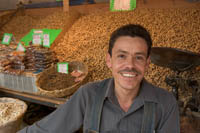 Vendors tend to be grouped together by product categories, so if you’re looking for something in particular, it’s best to ask directions to that part of the market, although within this order there is also a random mix of vendors outside of their product zone. Most vendors know numbers and prices in English. Some also know enough to point you in the right direction to find what you’re looking for. Toiletries, perfumes, watches, office supplies, groceries
everything but packaged liquor and pharmaceuticals can be bought at the market.
Vendors tend to be grouped together by product categories, so if you’re looking for something in particular, it’s best to ask directions to that part of the market, although within this order there is also a random mix of vendors outside of their product zone. Most vendors know numbers and prices in English. Some also know enough to point you in the right direction to find what you’re looking for. Toiletries, perfumes, watches, office supplies, groceries
everything but packaged liquor and pharmaceuticals can be bought at the market.
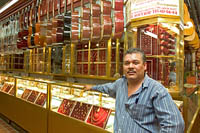 There’s a section for handmade leather goods, from belts to jackets to boots to hats. There are long counters of silver and gold jewelry with guitars hanging overhead, an odd, but common combination in this market. Guitars seem to go with anything.
There’s a section for handmade leather goods, from belts to jackets to boots to hats. There are long counters of silver and gold jewelry with guitars hanging overhead, an odd, but common combination in this market. Guitars seem to go with anything.
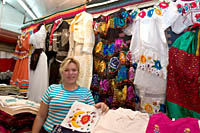 On the north side of level 2, along with cobblers and other shoe vendors, hardware (hammers, saws, etc.) can be found next to music CDs and electronics. Contemporary clothes and lots more shoes are on level three. If you’re looking for Mexican blankets, traditional clothes, sombreros or T-shirts, the first aisle along the east end closest to the parking structure has a good selection.
On the north side of level 2, along with cobblers and other shoe vendors, hardware (hammers, saws, etc.) can be found next to music CDs and electronics. Contemporary clothes and lots more shoes are on level three. If you’re looking for Mexican blankets, traditional clothes, sombreros or T-shirts, the first aisle along the east end closest to the parking structure has a good selection.
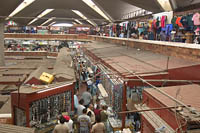 Levels two and three are open in the middle like a shopping mall, but rather than a fountain in the middle, you look down on the roofs of the first floor stalls. I could look across from the east side of level two and see all the food vendors on the west side, but I never made it over there in my three hours of exploring. I did come across another area of sandwich booths on the south side selling a variety of tortas (sandwiches on large rolls) between the butchers and the spice vendors.
Levels two and three are open in the middle like a shopping mall, but rather than a fountain in the middle, you look down on the roofs of the first floor stalls. I could look across from the east side of level two and see all the food vendors on the west side, but I never made it over there in my three hours of exploring. I did come across another area of sandwich booths on the south side selling a variety of tortas (sandwiches on large rolls) between the butchers and the spice vendors.
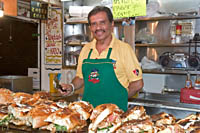 For American sensibilities, the butcher aisle is a bit of a culture shock. Every part of the animal is hanging in front of you, exposed to the air and available for purchase. Seeing all the hanging heads, feet and intestines didn’t really give me much of an appetite, but I found it fascinating.
For American sensibilities, the butcher aisle is a bit of a culture shock. Every part of the animal is hanging in front of you, exposed to the air and available for purchase. Seeing all the hanging heads, feet and intestines didn’t really give me much of an appetite, but I found it fascinating.
I am not much of a shopper, but I could have spent all day meandering through the stalls. Alas, I had other places to go and things to do, so I’ll have to venture back to Guadalajara to see what’s on the other side of the Mercado San Juan de Dios another time.
Mercado Libertad (San Juan de Dios) is located on Avenida Javier Mina at Calle Independencia and is open 6 a.m. to 8 p.m. daily. Some vendors close or keep shorter hours on Sunday.

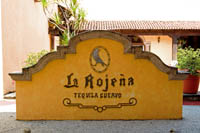 Mundo Cuervo as you have time for and fits into your budget. At the main distillery in Tequila, you can show up for a basic factory tour, which includes a tour of the distillery, La Rojeńa (named for the Cuervo son-in-law, Vincente Albino-Rojas, who acquired it as his wife’s dowry in 1812), access to the restaurant, gallery and gift shop and a margarita at the Margarita Bar. A Tasting Tour adds a sit-down tequila tasting in the Margarita Bar. A Reserva Cellar Tour adds a visit to the exclusive Reserva de la Familia (Family Reserve) aging cellar and a tasting of this premium tequila straight from the barrel under the supervision of the house tequillero. The VIP Tour is a private tour including all of the above. As of Nov 2005 prices range from 75 pesos ($7.50 US) for a basic factory tour to 250 pesos ($25 US) for a VIP Tour.
Mundo Cuervo as you have time for and fits into your budget. At the main distillery in Tequila, you can show up for a basic factory tour, which includes a tour of the distillery, La Rojeńa (named for the Cuervo son-in-law, Vincente Albino-Rojas, who acquired it as his wife’s dowry in 1812), access to the restaurant, gallery and gift shop and a margarita at the Margarita Bar. A Tasting Tour adds a sit-down tequila tasting in the Margarita Bar. A Reserva Cellar Tour adds a visit to the exclusive Reserva de la Familia (Family Reserve) aging cellar and a tasting of this premium tequila straight from the barrel under the supervision of the house tequillero. The VIP Tour is a private tour including all of the above. As of Nov 2005 prices range from 75 pesos ($7.50 US) for a basic factory tour to 250 pesos ($25 US) for a VIP Tour.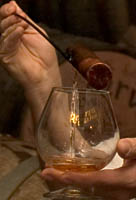 When the Spaniards colonized Mexico in the 1500s, they found the native people drinking a fermented beverage called pulque made from the heart of the maguey or agave plant. The Spaniards were running low on the spirits they had brought with them from Spain, so they distilled the pulque, creating the first mezcal wine. After a temporary ban on mezcal production in 1785, the King of Spain granted José Cuervo (Joe Crow) the first official license to produce mezcal wine in 1795. The Cuervo distillery was the first to give the name “tequila” to the type of mezcal wine produced exclusively from the heart of blue agave plants. With few exceptions, to have the designation of “tequila,” a mezcal must be produced from blue agave grown in the dry highlands of Jalisco and a few surrounding states and distilled in this same area.
When the Spaniards colonized Mexico in the 1500s, they found the native people drinking a fermented beverage called pulque made from the heart of the maguey or agave plant. The Spaniards were running low on the spirits they had brought with them from Spain, so they distilled the pulque, creating the first mezcal wine. After a temporary ban on mezcal production in 1785, the King of Spain granted José Cuervo (Joe Crow) the first official license to produce mezcal wine in 1795. The Cuervo distillery was the first to give the name “tequila” to the type of mezcal wine produced exclusively from the heart of blue agave plants. With few exceptions, to have the designation of “tequila,” a mezcal must be produced from blue agave grown in the dry highlands of Jalisco and a few surrounding states and distilled in this same area.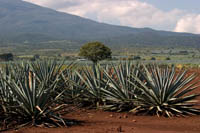 Coming from Guadalajara you drive through miles of the spiky blue-green agave, which, despite rumors to the contrary, is not a cactus. This succulent is part of the lily family which also includes its cousin, yucca. On an organized tour, your first stop is at one of these agave fields on the Cuervo plantation. If it’s wet, be sure to stick to the stone driveway or you’ll sink into the wet clay of the fields.
Coming from Guadalajara you drive through miles of the spiky blue-green agave, which, despite rumors to the contrary, is not a cactus. This succulent is part of the lily family which also includes its cousin, yucca. On an organized tour, your first stop is at one of these agave fields on the Cuervo plantation. If it’s wet, be sure to stick to the stone driveway or you’ll sink into the wet clay of the fields.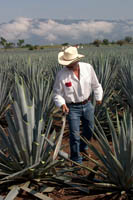 Here, we learn that an agave plant takes eight to twelve years to mature enough for harvesting and can grow to 12 or 14 feet in diameter. A jimador (agave harvester) demonstrates how the spikes are cut off the leaves of the agave with a machete to make them less sharp to work with; to force the nutrients to the heart of the agave, making it grow larger; and to prevent butterflies from nesting in the tips. The butterfly larvae or worms that are sometimes found in a bottle of mezcal, are never found in tequila. “If it is tequila” says Guillermo, our English-speaking guide, “there is no worm.” If left to grow wild, the agave would sprout a tall flower in the center, but these are also cut off to make the heart grow larger and sweeter.
Here, we learn that an agave plant takes eight to twelve years to mature enough for harvesting and can grow to 12 or 14 feet in diameter. A jimador (agave harvester) demonstrates how the spikes are cut off the leaves of the agave with a machete to make them less sharp to work with; to force the nutrients to the heart of the agave, making it grow larger; and to prevent butterflies from nesting in the tips. The butterfly larvae or worms that are sometimes found in a bottle of mezcal, are never found in tequila. “If it is tequila” says Guillermo, our English-speaking guide, “there is no worm.” If left to grow wild, the agave would sprout a tall flower in the center, but these are also cut off to make the heart grow larger and sweeter.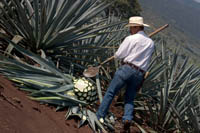 The jimador demonstrates on another plant how the agave is harvested, using a flat blade tool called a coa to cut off the leaves exposing the heart of the agave or pińa (called pineapple for its shape). The pińas usually weigh anywhere from 80 to 200 pounds. A good jimador can harvest over a ton of pińas in a day. The pińas are loaded onto trucks and taken into town to the distillery. Our jimador slices one in half and cuts off slivers for us to taste. It reminds me of jicama, a texture similar to a potato, but sweeter.
The jimador demonstrates on another plant how the agave is harvested, using a flat blade tool called a coa to cut off the leaves exposing the heart of the agave or pińa (called pineapple for its shape). The pińas usually weigh anywhere from 80 to 200 pounds. A good jimador can harvest over a ton of pińas in a day. The pińas are loaded onto trucks and taken into town to the distillery. Our jimador slices one in half and cuts off slivers for us to taste. It reminds me of jicama, a texture similar to a potato, but sweeter.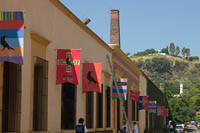 From the agave fields we continue into the town of Tequila, where the Cuervo factory, La Rojeńa, takes pride of place in the center of town, just off the plaza. The buildings of Mundo Cuervo actually fill two blocks on opposite sides of Calle José Cuervo. The Sauza Family Museum is on the other side of an adjoining wall and the National Tequila Museum is across Calle Ramon Corona. Street names change almost every block.
From the agave fields we continue into the town of Tequila, where the Cuervo factory, La Rojeńa, takes pride of place in the center of town, just off the plaza. The buildings of Mundo Cuervo actually fill two blocks on opposite sides of Calle José Cuervo. The Sauza Family Museum is on the other side of an adjoining wall and the National Tequila Museum is across Calle Ramon Corona. Street names change almost every block.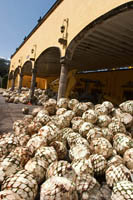 The main entrance to Mundo Cuervo is through an archway on the left side of Calle José Cuervo, across the street from Mundo Cuervo’s Cholula restaurant. The courtyard entrance to the factory is filled with a giant sculpture of a bird, representing the Cuervo crow, an oft repeated theme throughout Mundo Cuervo. Its live counterpart has pride of place in a cage in an inner courtyard. The Cuervo tour is an indoor-outdoor experience, but if it’s raining, they have enough umbrellas for everyone.
The main entrance to Mundo Cuervo is through an archway on the left side of Calle José Cuervo, across the street from Mundo Cuervo’s Cholula restaurant. The courtyard entrance to the factory is filled with a giant sculpture of a bird, representing the Cuervo crow, an oft repeated theme throughout Mundo Cuervo. Its live counterpart has pride of place in a cage in an inner courtyard. The Cuervo tour is an indoor-outdoor experience, but if it’s raining, they have enough umbrellas for everyone.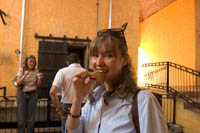 The pińas cook in the steam ovens for 36 hours to convert the starches to sugar. We get to taste a slice of the cooked agave. Although the sign says it tastes like yam, I find it much sweeter, almost like raw sugar cane, but with a tequila aftertaste.
The pińas cook in the steam ovens for 36 hours to convert the starches to sugar. We get to taste a slice of the cooked agave. Although the sign says it tastes like yam, I find it much sweeter, almost like raw sugar cane, but with a tequila aftertaste.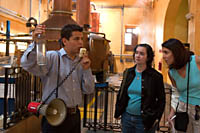 The brown fermented liquid is then distilled twice in copper stills resulting in a clear tequila that is about 55% alcohol. Since 40% is the maximum allowed, it has to be diluted with de-mineralized water to reduce the alcohol content. This fresh tequila,Tequila Blanco – also called plata or silver – is stored in stainless steel vats and bottled within 15 days.
The brown fermented liquid is then distilled twice in copper stills resulting in a clear tequila that is about 55% alcohol. Since 40% is the maximum allowed, it has to be diluted with de-mineralized water to reduce the alcohol content. This fresh tequila,Tequila Blanco – also called plata or silver – is stored in stainless steel vats and bottled within 15 days.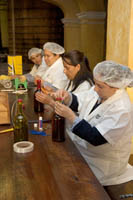 French oak barrels. Tequila aged from two months to a year is considered Tequila Reposado or rested. Aging in wood adds color as well as flavor to the tequila. Tequila aged a year or more is Tequila Ańejo. These are grades of tequila, not brands. The tour guide explains the differences between Cuervo’s various tequila brands.
French oak barrels. Tequila aged from two months to a year is considered Tequila Reposado or rested. Aging in wood adds color as well as flavor to the tequila. Tequila aged a year or more is Tequila Ańejo. These are grades of tequila, not brands. The tour guide explains the differences between Cuervo’s various tequila brands.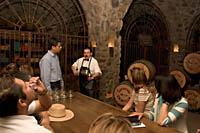 A tequillero extracts a measure of amber tequila directly from the barrel and pours it into a brandy snifter for each guest. Just like a wine tasting, we are instructed how to test the bouquet, the color and the body of the tequila before tasting it. This is definitely a sipping tequila, having many of the same properties as a good cognac or brandy.
A tequillero extracts a measure of amber tequila directly from the barrel and pours it into a brandy snifter for each guest. Just like a wine tasting, we are instructed how to test the bouquet, the color and the body of the tequila before tasting it. This is definitely a sipping tequila, having many of the same properties as a good cognac or brandy.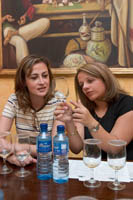 The problem with having the regular tequila testing after our visit to the Cellar is that nothing can compare with the Reserva we have just tasted. However, our palates are cleared a bit with the frozen margaritas that greet us in the courtyard of the Margarita Bar. Inside, the table is pre-set with three capped glasses of tequila at each place and a bilingual cheat sheet reviewing what to look for in a tasting. Interestingly, the three tequilas presented in the tasting are not even José Cuervo labels, they are a Blanco, a Reposado and an Ańejo that Cuervo produces under its Gran Centenario label.
The problem with having the regular tequila testing after our visit to the Cellar is that nothing can compare with the Reserva we have just tasted. However, our palates are cleared a bit with the frozen margaritas that greet us in the courtyard of the Margarita Bar. Inside, the table is pre-set with three capped glasses of tequila at each place and a bilingual cheat sheet reviewing what to look for in a tasting. Interestingly, the three tequilas presented in the tasting are not even José Cuervo labels, they are a Blanco, a Reposado and an Ańejo that Cuervo produces under its Gran Centenario label.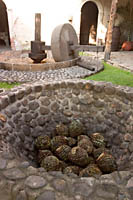 Off of the courtyard by the Margarita Bar is a gallery that wraps around to a gift shop selling fine art and hand crafts. Across the street, in an open courtyard, you can see part of the original distillery where the agave were roasted in underground pits and then milled with a grinding stone pulled by a mule. Another gift shop, where you can buy tequila and related products is in this courtyard.
Off of the courtyard by the Margarita Bar is a gallery that wraps around to a gift shop selling fine art and hand crafts. Across the street, in an open courtyard, you can see part of the original distillery where the agave were roasted in underground pits and then milled with a grinding stone pulled by a mule. Another gift shop, where you can buy tequila and related products is in this courtyard.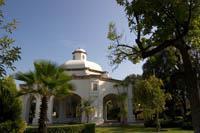 The gardens of the hacienda include a large gazebo often used for weddings and dances and a rodeo ring for charreria demonstrations. Through a fence, you can see the homestead where the family still stays when they are in town.
The gardens of the hacienda include a large gazebo often used for weddings and dances and a rodeo ring for charreria demonstrations. Through a fence, you can see the homestead where the family still stays when they are in town.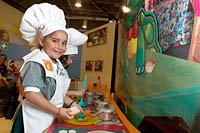 If you’re traveling with kids and they’ve had their fill of Guadalajara’s colonial history, head over to neighboring Zapopan to El Trompo Mágico, the Magic Top, for an indoor play day for the whole family. This interactive museum, which opened in 2003, has activities for kids of all ages. It’s not uncommon to see adults on their own or groups of seniors visiting Trompo Mágico as well.
If you’re traveling with kids and they’ve had their fill of Guadalajara’s colonial history, head over to neighboring Zapopan to El Trompo Mágico, the Magic Top, for an indoor play day for the whole family. This interactive museum, which opened in 2003, has activities for kids of all ages. It’s not uncommon to see adults on their own or groups of seniors visiting Trompo Mágico as well.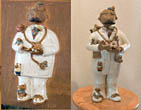 The Museum was designed as an educational enhancement to school curricula, but it won’t feel like school. The mission of Trompo Mágico is to develop a learning environment that will “uphold universal values while empowering people committed to a better world.” There are exhibits reflecting the themes of peace, diversity, equality and tolerance, but if you don’t speak Spanish you might mistake them for just more fun and eye candy.
The Museum was designed as an educational enhancement to school curricula, but it won’t feel like school. The mission of Trompo Mágico is to develop a learning environment that will “uphold universal values while empowering people committed to a better world.” There are exhibits reflecting the themes of peace, diversity, equality and tolerance, but if you don’t speak Spanish you might mistake them for just more fun and eye candy.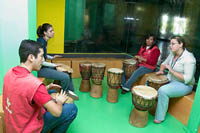 The museum is filled with helpful Nei’wáma (plural for Nei’wá, meaning friend, companion or guide in the Huichol language) to facilitate the learning experience. They can be identified by their brightly colored vests. Many of the Nei’wá are students from local colleges doing required community service hours.
The museum is filled with helpful Nei’wáma (plural for Nei’wá, meaning friend, companion or guide in the Huichol language) to facilitate the learning experience. They can be identified by their brightly colored vests. Many of the Nei’wá are students from local colleges doing required community service hours.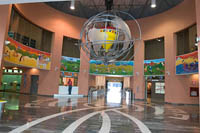 You enter the museum into a large lobby with a cutout globe around a yellow spinning top overhead. After buying your tickets, most of what you want to see and do is through the Voy Derecho (Straight Ahead) Hall of Children’s Rights, filled with touchable sculptures by local artist Rodolfo Padilla, and around the circular courtyard (or across if it’s not raining) to the Pabellón Mágico (Magic Pavilion).
You enter the museum into a large lobby with a cutout globe around a yellow spinning top overhead. After buying your tickets, most of what you want to see and do is through the Voy Derecho (Straight Ahead) Hall of Children’s Rights, filled with touchable sculptures by local artist Rodolfo Padilla, and around the circular courtyard (or across if it’s not raining) to the Pabellón Mágico (Magic Pavilion).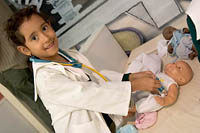 From the entrance of the Pabellón Mágico, to the far right is Maroma (Summersault), a children’s role play area. Here little ones can don the appropriate garb and get to work making tortillas and selling vegetables in a child-size market; creating and stamping letters at a mini post office; administering shots and listening for baby doll heartbeats at the hospital; cooking up and serving some yummy play food at the restaurant; or building something monumental at the construction site.
From the entrance of the Pabellón Mágico, to the far right is Maroma (Summersault), a children’s role play area. Here little ones can don the appropriate garb and get to work making tortillas and selling vegetables in a child-size market; creating and stamping letters at a mini post office; administering shots and listening for baby doll heartbeats at the hospital; cooking up and serving some yummy play food at the restaurant; or building something monumental at the construction site.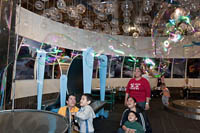 Behind Maroma to the left is Burbujas, the bubble area. I have seen a lot of cool bubble exhibits at science museums around the U.S., but this is by far the best I’ve come across. I am not quite sure how making giant soap bubbles teaches responsible consumption of water. The message gets lost in the fun of creating a giant string of bubble that stretches across the room; using teamwork to wrap a huge bubble from two long soapy poles; putting your soapy hand in and out of a sheet of bubble without breaking it, or, best of all, getting inside a massive tube of bubble.
Behind Maroma to the left is Burbujas, the bubble area. I have seen a lot of cool bubble exhibits at science museums around the U.S., but this is by far the best I’ve come across. I am not quite sure how making giant soap bubbles teaches responsible consumption of water. The message gets lost in the fun of creating a giant string of bubble that stretches across the room; using teamwork to wrap a huge bubble from two long soapy poles; putting your soapy hand in and out of a sheet of bubble without breaking it, or, best of all, getting inside a massive tube of bubble.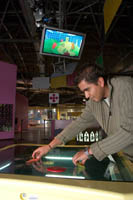 In the Garabato (Scribble) exhibit, you might expect something to do with painting, or drawing, but in reality, you’ll find a variety of high tech exhibits on modern cultural expression demonstrating how art and science come together in daily life. On the low tech end, you can join in a drum circle with traditional Brazilian drums. If you want to go more high tech, you can sit in on a jam session with electronic musical instruments. Children and adults can learn how a radio station broadcasts; create your own film and learn to edit it; experiment with four different ways of creating animated films; try your hand at digital photography; and learn how a newspaper is put together.
In the Garabato (Scribble) exhibit, you might expect something to do with painting, or drawing, but in reality, you’ll find a variety of high tech exhibits on modern cultural expression demonstrating how art and science come together in daily life. On the low tech end, you can join in a drum circle with traditional Brazilian drums. If you want to go more high tech, you can sit in on a jam session with electronic musical instruments. Children and adults can learn how a radio station broadcasts; create your own film and learn to edit it; experiment with four different ways of creating animated films; try your hand at digital photography; and learn how a newspaper is put together.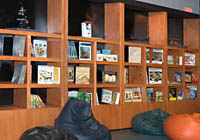 biodiversity of the planet. Learn how a tornado is formed or take a virtual reality submarine tour. The final area, Eureka, has hands-on and interactive computer exhibits allowing you to operate robots, take trip into space and explore telecommunications possibilities. This area also includes the IBM Try Science exhibit, a computer game that gives you points for learning the science behind the action.
biodiversity of the planet. Learn how a tornado is formed or take a virtual reality submarine tour. The final area, Eureka, has hands-on and interactive computer exhibits allowing you to operate robots, take trip into space and explore telecommunications possibilities. This area also includes the IBM Try Science exhibit, a computer game that gives you points for learning the science behind the action.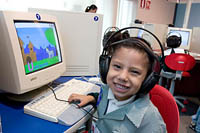 The Mediateca(Computer Room) offers dozens of computer terminals with fun and educational programs for all ages designed by the in-house educational media team. Off the main lobby is the Museum store and the temporary exhibit hall with rotating exhibits. Through February 2006, an exhibit on Charreria, Mexico’s cowboy and rodeo tradition, includes regularly scheduled
The Mediateca(Computer Room) offers dozens of computer terminals with fun and educational programs for all ages designed by the in-house educational media team. Off the main lobby is the Museum store and the temporary exhibit hall with rotating exhibits. Through February 2006, an exhibit on Charreria, Mexico’s cowboy and rodeo tradition, includes regularly scheduled 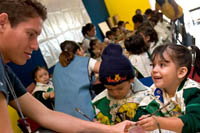 roping demonstrations. At the other end of the building, three workshops provide hands-on arts and science projects for children, teens and parents. Upstairs, a gallery between the administrative offices and the circular conference room hosts art exhibits.
roping demonstrations. At the other end of the building, three workshops provide hands-on arts and science projects for children, teens and parents. Upstairs, a gallery between the administrative offices and the circular conference room hosts art exhibits.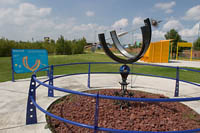 explore. Three playgrounds with age-appropriate equipment for pre-school, elementary and secondary students are near the cafeteria. On the opposite side, the Peace Labrynth is a circular maze where various activities are held promoting non-violent conflict resolution. Beyond that, on weekends and holidays you’ll find Voy que Vuelo (I can fly), which includes a sky diving simulator and canopy ride (additional fee).
explore. Three playgrounds with age-appropriate equipment for pre-school, elementary and secondary students are near the cafeteria. On the opposite side, the Peace Labrynth is a circular maze where various activities are held promoting non-violent conflict resolution. Beyond that, on weekends and holidays you’ll find Voy que Vuelo (I can fly), which includes a sky diving simulator and canopy ride (additional fee).